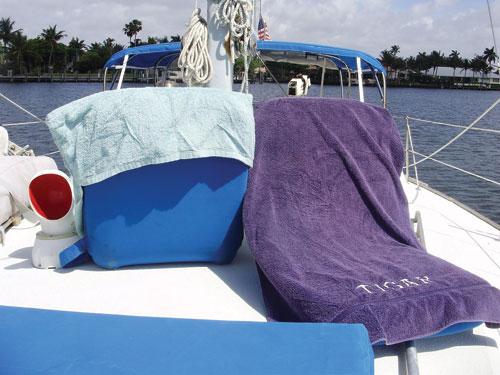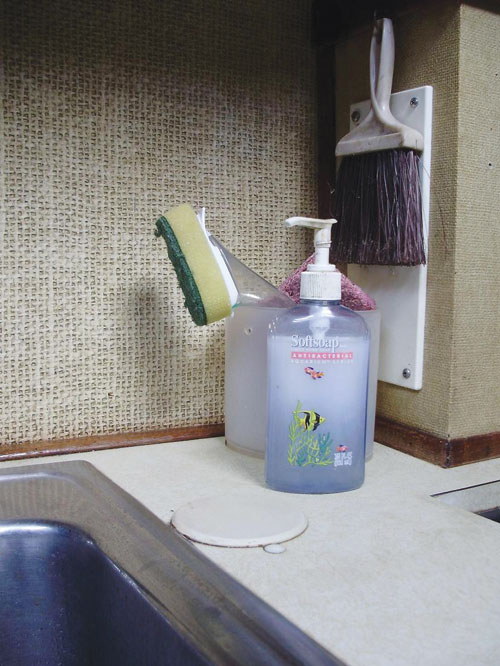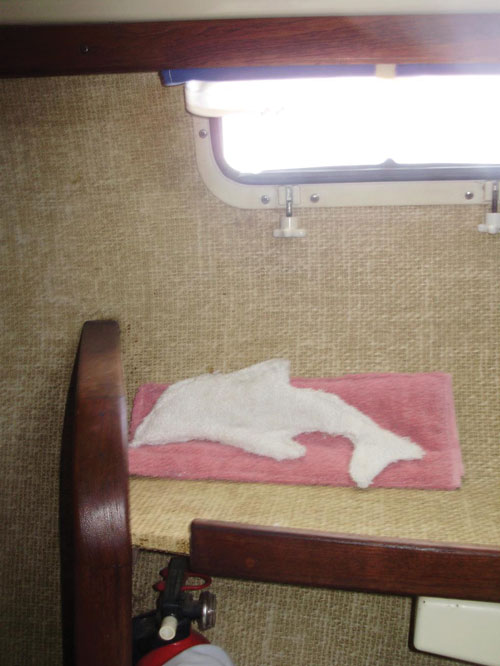Quick Fixes
Simple solutions to little problems will make your cruising time more comfortable, relaxing and enjoyable
My wife and I aren't world cruisers. We are never going to be world cruisers. Our 33-foot Morgan Out Island is not that capable and neither are we. But since we moved to South Florida 13 years ago we have done a lot of cruising-about 60 days per year. That includes our yearly three-week trip to the Bahamas, trips to the Florida Keys and a whole lot of two- to three-day cruises around South Florida. That works out to almost three years of days (and nights) onboard. In that time, we have discovered some simple solutions to make our cruising time as enjoyable as possible.We aren't reinventing the wheel, just providing a "baker's dozen" of simple ideas to make your boat time more a pleasure than an ordeal. None of them costs much money; most only a few dollars and some elbow grease. Which proves that once you have your sailboat, the sport doesn't have to be expensive. 
Color code your tools
On rare occasions-very rare-our engine has stopped. When a diesel engine stops the cause is usually fuel starvation, i.e. clogged filters. For purging the system of air, I need three different sized wrenches. At best this is a tedious job. At the worst, I am anxious to get back underway. For jobs like this, rather than rummaging through my tools to find the correct sized wrench, I've marked the ones I need with colored plastic tape. (They could also be marked with nail polish.) You can easily mark the same size wrench for different jobs with different colors.
Fly "Old Glory" proudly

We fly our American flag when we sail. Unfortunately it doesn't take long for even a high-quality flag to begin to show some wear. I coat the stitching on the outer edge with clear silicone sealant to extend its life and appearance. When dry, the silicone is invisible and very effective at preventing the thread from deteriorating.
Sop up little leaks
Let's face it. Even the driest vessel has some persistent leaks, and they are buggers to track down. Water doesn't flow in a straight line. A leak on the toerail near the bow could appear anywhere inside the cabin. I've given up on a couple and adapted to the situation. I've taken bath towels that my wife deems no longer suitable for use and cut them into squares (a large towel cut once widthwise and twice lengthwise creates six squares). I then fold them over to a third its size and stitch the ends. The pad is perfect to set below a persistent leak. Choose a coordinating color to your sailboat's interior and it's reasonably attractive. After they do what they are supposed to do, set them out to dry. When necessary, toss them in the washing machine. If they become stained and tattered, they are usable as soft pads for washing the deck.
Freshen up cabins and lockers
Most of us are weekend sailors. A sailboat that is sealed up for a week will develop a stagnant smell that tends to be stronger in closed lockers and drawers. Toss a couple of fabric softener sheets into each cabinet or drawer. For the hanging locker, fasten the sheets to a hanger with a clothespin. This adds a bit of "freshness" to the air. Replace the sheets each month during the season. For confined areas, such as the head, we use Renuzit air fresheners. These puppies come in dozens of scents. Break the seal and twist the top to expose the deodorizer. If you are economy-minded, close them up when you leave your boat. However, if you leave them open you'll be greeted with a pleasant aroma on your next visit. They cost about $1 and are both economical and effective.
Use low-tech wind gauges

High-tech sailing instruments are great. We have electronic wind instruments, but we back it up with old reliable telltales. Salvage an old audiocassette, cut off two 12-inch pieces and tie to your stays. When they start to fray, replace with new pieces. One cassette should last for years.
Create cushion covers
We bought our first cockpit "jackknife" chairs more than 10 years ago. In order to keep them clean and add to the comfort, I created a slipcover for each from bath towels. Sew a pocket on one end (fold over approximately six inches and stitch the ends). Slip the pocket over the top of the cushion. When the cover becomes soiled take it off and wash it. Create a few spares. On a three-week cruise we use many covers.
Identify your boat

After dinner ashore we often found it difficult to identify our sailboat in crowded anchorages in the dark. I affixed a strip of reflective tape to each side of the boom end. Now, when we return to our "home away from home," our flashlight can pick out our boat from the others. However, if this becomes too popular among the other boats, we are going to have to cut a unique shape to the tape to further set it apart.
More towel tips
The floor space of our head is about two feet by two feet. That's a small space for the sink, toilet, storage and shower, but pretty typical on sailboats in the 30- to 35-foot range. When we shower, everything gets wet. Some of the water used to creep past the door into the cabin. Now, before showering, I lay a towel outside the door to catch any spray. When I'm finished, I use that same towel to dry the surfaces to keep my crew happy. I hang the towel to dry and then stow it for the next day. On a three-week cruise, we set several towels aside for this purpose.
Organize the icebox
Our top-loading refrigerator is pretty efficient. The biggest problem was that small items tended to get lost in the bottom of the box. We purchased soft-sided lunch cooler bags to stow many items. Currently we have three bags in different colors: blue for breakfast items (B=breakfast), light green (lettuce colored) for lunch preparations (L=lunch), and red for other items (R=everything else). These bags conform to the shape available and don't take up as much space as hard containers or baskets.
Tidy-bowl your hull
We thought yellow hull stains were a problem that was confined to the Intracoastal Waterway. It turns out that this "ICW Smile" is a problem for boats everywhere. We discovered that it comes off easily with toilet bowl cleaner. This is a pretty caustic product, so wear rubber gloves, old clothing and protect your inflatable from run-off. Squirt it on a rag or sponge. The stain comes off with a minimal amount of rubbing. Wipe off as much cleaner as possible, then rinse thoroughly. If your hull has been painted, test it first to see if it affects the paint. The name brands don't work any better than what the discount stores sell, and one bottle lasts a long time.
Save those plastic jars
When I was a kid, my father saved tin cans to sort and store all kinds of odds and ends. Cans aren't practical for boaters. Besides, they have been replaced by a better storage option: plastic jars. Almost everything that used to be sealed in cans now comes in plastic jars. These are great for boaters. They are clear, so the contents are visible, the screw-on lids seal tight to keep moisture out, and they're free! We use them all over our sailboat. In the galley, the quart-sized jars are used as canisters for coffee, tea and candy bars. We use eight-ounce jars to store salad dressings and sauces in the refrigerator. I have a few favorites that I use when draining fuel to replace filter elements. Even the small ones have a use for storing nuts, bolts, washers and small fittings.
Switch to liquid soap
There is not much worse than a slimy bar of soap, unless it's a dried-up bar of soap that's harder than a walnut shell. We use liquid soap pump dispensers in the galley and the head. Squirt out what you need. The sealed container keeps the remainder fresh and ready to use. The dispensers cost about a buck and 64-ounce refill containers are available in many scents for about $5.
Cut the power
If your boat sits in salt water, corrosion can be a big problem. The mixture of metals below the waterline combined with salt water creates galvanic corrosion. Add to that stray current from a neighboring vessel and you'll go through shaft zincs very quickly. My shaft zinc costs about $15 and I change it myself. If I had a diver do it, he would charge an additional $30. Simple solution: Disconnect the shore-power cord to minimize problems from stray current when you are at your home dock (unless you have something that is powered by 110-volt). Sure, the batteries will discharge, but if they are in good condition the discharge will only be slight from one weekend to the next. With your vessel isolated, the zinc's life will be extended.

Comments